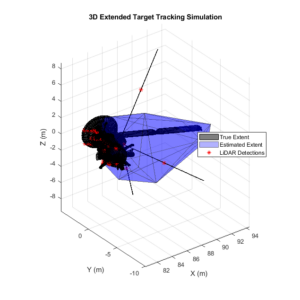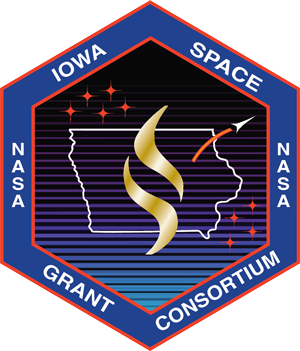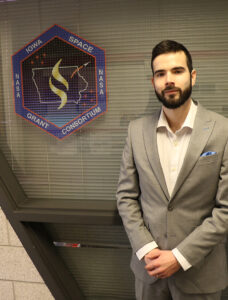 My current work is concerned with Light Detection and Ranging (LiDAR) sensing for spacecraft rendezvous maneuvers. Although LiDAR has been used in spacecraft relative navigation for decades, existing methods require target-mounted reflectors to identify and track the target. In many cases, such as spacecraft debris removal, on-orbit servicing, and asteroid rendezvous, navigational aids may be unavailable. An improved image processing algorithm is needed to enable LiDAR-based navigation in these situations. Extended target tracking (ETT), defined as the estimation of the extent and kinematics of one or more objects in a surveillance region based on sparse sets of sensor measurements collected over time, has the potential to supply navigational information for spacecraft. Multiple researchers have developed ETT algorithms for autonomous driving, but cars are constrained to 3 degrees of freedom. This project seeks to develop a novel 6-degree-of-freedom ETT algorithm for spacecraft relative navigation. The resulting technology will extract more navigational information from on-orbit LiDAR measurements than previously possible by tracking the shape, pose, and kinematics of target satellites in 3D.
My current work is concerned with Light Detection and Ranging (LiDAR) sensing for spacecraft rendezvous maneuvers. Although LiDAR has been used in spacecraft relative navigation for decades, existing methods require target-mounted reflectors to identify and track the target. In many cases, such as spacecraft debris removal, on-orbit servicing, and asteroid rendezvous, navigational aids may be unavailable. An improved image processing algorithm is needed to enable LiDAR-based navigation in these situations. Extended target tracking (ETT), defined as the estimation of the extent and kinematics of one or more objects in a surveillance region based on sparse sets of sensor measurements collected over time, has the potential to supply navigational information for spacecraft. Multiple researchers have developed ETT algorithms for autonomous driving, but cars are constrained to 3 degrees of freedom. This project seeks to develop a novel 6-degree-of-freedom ETT algorithm for spacecraft relative navigation. The resulting technology will extract more navigational information from on-orbit LiDAR measurements than previously possible by tracking the shape, pose, and kinematics of target satellites in 3D.
The first step of this project was to generate synthetic LiDAR data by simulating a spacecraft rendezvous scenario. Currently, I am adapting an established ETT algorithm to track the simulated spacecraft. This research is in response to NASA Technology Area 5.4.3: Sensors and Vision Processing Systems. It is directly applicable to the NASA Space Operations Mission Directorate, enhancing rendezvous maneuvers in space transportation and making exploration safer with detailed space debris information. This work will also contribute to the NASA Space Technology Mission Directorate, as it applies to navigation in orbit around the Moon or Mars.

